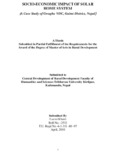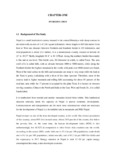Please use this identifier to cite or link to this item:
https://elibrary.tucl.edu.np/handle/123456789/2341| Title: | Socio-Economic Impact of Solar Home System: A Case Study of Gwagha VDC, of Gulmi District |
| Authors: | Khatri, Laxmi |
| Keywords: | Alternative energy;Solar Energy;Renewable energy;Gulmi |
| Issue Date: | Apr-2010 |
| Publisher: | Central Department of Rural Development Tribhuvan University, Kathmandu |
| Abstract: | Energy is essential for meeting basic human needs. The improvement in quality of poor rural life is one of the most cherished goals of all developing countries. This goal can not be achieved in absence of adequate energy and proper utilization of natural resources that a country possesses. Most of the households in our country from rural area where poverty is deep rooted the main reasons behind the poverty are lack of energy and miss utilization of local resources. Because of lack of knowledge and poor economic condition, peoples living in rural area are compelled to use the traditional type of energy sources that has made the pressure on forest resource. With a per capita energy consumption of about 15 GJ, Nepal is one of the five least energy consuming countries in the world. Solar energy is one of the most important renewable energy in the hilly areas of Nepal. Because Nepal lies in the sunny regions of the world most part of Nepal receive 6.8 Kwh (kilowatt-hour) of solar radiation per square meter per day with 250-300 sunny days a year. Solar energy, experienced by us as heat and light, can be used through two routes: the thermal route uses the required for many purposes in the domestic, agricultural, industrial and commercial sector of the economy such as: heat for water heating, cooking, drying, water purification and other application; the photovoltaic route converts the light in solar energy into electricity using a device made of silicon or other materials, which can then be used for a number of purposes such as lighting, pumping, communication and power supply in un-electrified areas. Energy from the sun has many features, which make it an attractive and sustainable option: global distribution, pollution free nature, and the virtually inexhaustible supply (AET, 2007). This study has analysed socio-economic impact of solar home system of Gwagha VDC of Gulmi district. For this research the objectives are to identify the various uses of SHS in the VDC, to explore the socio-economic status of SHS user community of rural area, to provide a basis of theoretical as well as practical concept and knowledge for further study and research on rural energy SHS. The research is based on primary and secondary data. For collecting the primary data household survey was conducted. The study has found many benefits of SHS, as it not only provide energy for lighting but also helps in improving health, time saving, easy to work at night and comfortable to children’s study. In the study area, economically active population is 56.65percent. the education status is higher than national i.e. 89.24% where higher education level is 5.18% is very low. It is also found that the average household size is 7.30. The main income source of the study area is pension which is 52.77%. Most of the SHS users are reported to have sufficient panel’s capacity. It is also found that 11.11 percent HHs are involving in income V generating work (PCOs) by using SHS. Consumption of kerosene and dry cell batteries has been reduced. Study analyzed that; poor people cannot afford it easily. Majority of people are benefited from the SHS are higher class ethnic groups than lower class ethnic groups. In the VDC there is lack of linkage between income generating activities and SHS electrification and also training and skill development programme. During the field visit it was found that the SHS is very much popular in Gwagha VDC. The SHS has replaced the kerosene lamps in this VDC. In some parts of the (study area) VDC, the grid line for a few (1/2) wards has been extended, with only few households wiring but due to it’s irregular the villagers feel that solar is more reliable than grid line. However the occurrence of certain problems is some of the components (eg. Charge controller, bulbs, distilled water etc) made the users to by pass charge controller and frequent change of bulbs time after time. After the installation of SHS, about 2-5 liters of kerosene consumption has reduced per month per households. But the dry cell batteries are still in use to operate torch lights and tukimara. For the rapid development and promotion of SHS, the area should be identified and local capability should be built up at village level. Simple and transparent procedures for loan sanctioning should be developed and institutionalized. Subsidy policy for SHS should be made consistent. There is a need to integrated SHS technology with income generating activities and proper evaluation and supervision should be done |
| URI: | http://elibrary.tucl.edu.np/handle/123456789/2341 |
| Appears in Collections: | Rural Development |
Files in This Item:
| File | Description | Size | Format | |
|---|---|---|---|---|
| Cover.pdf | 453.37 kB | Adobe PDF |  View/Open | |
| Introduction.pdf | 1.84 MB | Adobe PDF |  View/Open |
Items in DSpace are protected by copyright, with all rights reserved, unless otherwise indicated.
